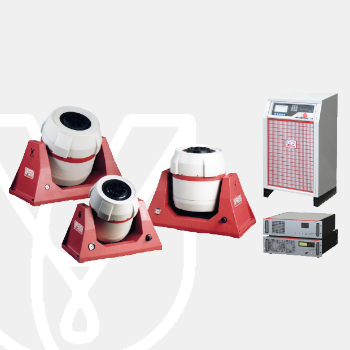
LDS Small Electromagnetic Vibration Systems
Industry Applications
- Automotive component testing
- Modal and structural analysis
- Electronic assembly testing
- Fatigue and resonance testing
- Use as a velocity transducer or high-speed actuator
- In-house testing and calibration
Industry Application
- Lightweight, high performance armature delivers excellent acceleration and velocity performance
- Powered by compact, quiet, and energy efficient amplifiers
- Robust, lightweight suspension provides excellent torsional and transverse stiffness with minimal impact on system acceleration
- Proven reliability maximises system availability
- Vertical and horizontal operations
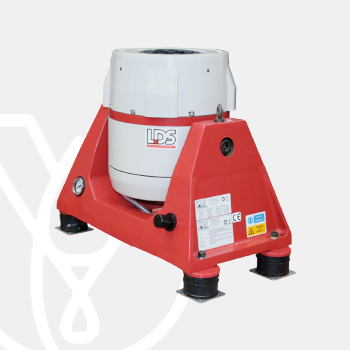
V555 Series
LOW-FORCE SHAKER
An air-cooled electrodynamic shaker for vibration testing of payloads up to 25 kg (55 lb), such as small automobile and aircraft components, electronic subassemblies and computer equipment. It has a maximum force rating of 940 N (211 lbf).
Designed to reproduce field vibration environments in controlled settings, LDS® V555 is used in R&D in the automotive, aerospace & defence, and consumer electronics industries – where strict standards demand that products be subjected to real-world conditions while ensuring safety during the testing process and confidence in the results.
USE SCENARIOS
- Testing of automotive components, such as motorcycle brake lines and seat belt mechanisms
- Aerospace component testing, including tests of aircraft instrumentation systems
- Testing of electronic assemblies
- Structural dynamics testing and modal analysis
- Vibration stress testing under varied environmental conditions
- In-house testing and calibration facilities
CHARACTERISTICS
The smallest of our low-force shakers, V555 is a dependable, versatile and cost-effective alternative for a variety of testing needs, including product qualification, quality assurance, machinery diagnostics and instrument calibration. Capable of delivering peak sine forces of 940 N (211 lbf) and operating in frequencies from 5 to 6300 Hz, this shaker is suitable for shock and vibration tests using sinusoidal and random excitations.
For enhanced acceleration and velocity performances, the armature assembly incorporates a unique suspension system specifically developed to offer better lateral and rotational restraints and axial stiffness. Additionally, a built-in pneumatic mechanism provides support for both the armature and the payload and allows the shaker to accommodate devices up to 25 kg (55 lb) for testing.
As standard, V555 comes mounted on a solid cast-iron trunnion and can be locked in the vertical or horizontal position for operation on either axis. The trunnion itself is supported by four air-isolation mounts to prevent shaker-generated vibrations from travelling through the floor; this is particularly useful for sine testing at very low frequencies.
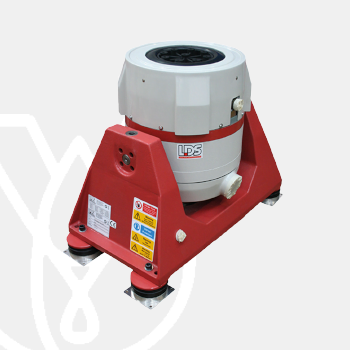
V650 Series
LOW-FORCE SHAKER
An air-cooled electrodynamic shaker for vibration testing of payloads up to 50 kg (110 lb), such as aircraft instrumentation and other electronic and mechanical subassemblies. It has a peak sine force rating of 2.2 kN (495 lbf).
LDS® V650 is used within the automotive, aerospace, commercial and defence aviation, and consumer electronics sectors, to reproduce field vibration environments in a controlled manner. It is ideal for R&D and quality assurance tests, where products need to be exposed to real-world conditions while maintaining the rigour and reliability that a laboratory setting affords.
USE SCENARIOS
- Testing of automotive components, such as motorcycle brake lines and seat belt mechanisms
- Aerospace component testing, including tests of aircraft instrumentation systems
- Testing of electronic assemblies
- Structural dynamics testing and modal analysis
- Vibration stress testing under varied environmental conditions
- In-house testing and calibration facilities
CHARACTERISTICS
Through a combination of generous force ratings, high accelerations and a wide frequency band, this shaker provides a versatile and cost-effective alternative for a variety of testing scenarios, including product qualification, machinery diagnostics and instrument calibration.
V650 is suitable for shock and vibration tests using sinusoidal and random excitations. It is capable of applying up to 2.2 kN (495 lbf) of sine force and operating at frequencies ranging from 5 to 4000 Hz. The shaker is equipped with a built-in pneumatic support system that can accommodate payloads of up to 50 kg (110 lb) with full relative displacement.
Velocity and acceleration performances are enhanced by the shaker’s armature fabrication, which incorporates a unique suspension mechanism to improve axial stiffness and lateral and rotational restraints.
As standard, V650 comes mounted on a solid cast-iron trunnion that can be locked in the vertical or horizontal position for operation in either axis. To prevent shaker-generated vibrations from travelling through the floor, the trunnion itself is supported by four air-isolation mounts; this feature is particularly useful for testing at low frequencies, as it reduces seismic interferences on test results.
Additionally, a number of optional and customizable features are available to tailor the shakers to your specific needs.
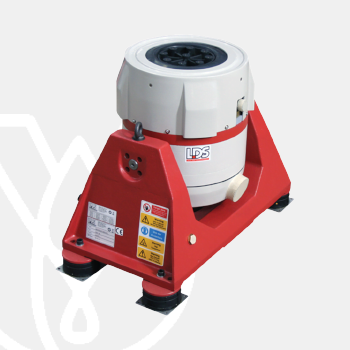
V721 Series
LOW-FORCE SHAKER
An air-cooled electrodynamic shaker for vibration testing of small- and medium-sized payloads up to 100 kg (220 lb), such as aircraft and automobile components, computer equipment, and other electronic and mechanical subassemblies. Maximum force rating of 2.9 kN (652 lbf).
Designed to re-create field vibration environments in controlled settings, LDS® V721 is used in R&D and quality assurance within the automotive, aerospace & defence, and consumer electronics sectors, where products must be exposed to real-world conditions while ensuring reliability and confidence in the testing process.
USE SCENARIOS
- Testing of automotive components, such as airbag actuators and seatbelt mechanisms
- Aerospace component testing, including tests of aircraft instrumentation systems
- Testing of electronic assemblies
- Structural dynamics testing and modal analysis
- Vibration stress testing under varied environmental conditions
- In-house testing and calibration facilities
CHARACTERISTICS
Compact-yet-powerful, this shaker combines a wide frequency band, maximum accelerations and relatively high forces to offer a versatile and cost-effective solution for a variety of testing needs that include product qualification, machinery diagnostics and instrument calibration.
Suitable for vibration and shock tests using sinusoidal and random excitations, V721 can impart peak sine forces of 2.9 kN (652 lbf) and operate in frequencies ranging from DC to 4000 Hz. Thanks to a built-in pneumatic load support system, the shaker is able to accommodate payloads up to 100 kg (220 lb) with full relative displacement.
For enhanced acceleration and velocity performances, the shaker’s armature incorporates a magnesium frame that is both lightweight and rugged; it also features a unique suspension mechanism that provides axial stiffness and improves lateral and rotational restraints.
Standard mounting for this shaker consists of a solid cast-iron trunnion which allows the thrust axis to be locked in the vertical or horizontal position. In turn, the trunnion supports are fitted with four air-isolation mounts to prevent shaker-generated vibrations from travelling through the floor.
Additionally, a number of optional and customizable features are available to tailor the V721 shaker systems to your specific needs.
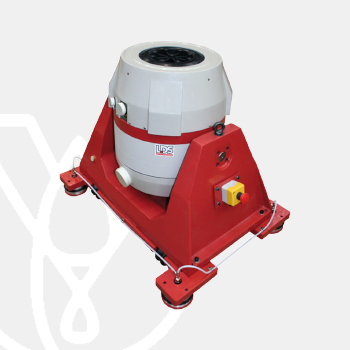
V780 Series
LOW-FORCE SHAKER
An air-cooled electrodynamic shaker for vibration and shock testing of small- and medium-sized payloads, up to 100 kg (220 lb), including aviation instrumentation, satellite components, automobile parts, computer equipment, and electronic and mechanical subassemblies. Peak force rating of 5.12 kN (1150 lbf).
Designed to reproduce field vibration environments in a controlled manner, LDS® V780 is ideal for tests in which articles must be subjected to real-world conditions while maintaining the safety and reliability standards found in laboratories. It is widely used in R&D and quality assurance by the automotive, aerospace and defence, and consumer electronics industries.
USE SCENARIOS
- Testing of automotive components, such as airbag actuators and seatbelt mechanisms
- Aerospace component testing, including aircraft instrumentation tests
- Testing of electronic assemblies and subassemblies
- Structural dynamics tests and modal analysis
- Vibration stress testing under varied environmental conditions
- In-house testing and calibration facilities
CHARACTERISTICS
The most powerful shaker in our low-force range, V780 is also capable of achieving high accelerations while operating in a wide frequency band – a combination that makes it the versatile and economical choice for a number of testing scenarios, such as product qualification, quality assurance, machinery diagnostics and instrument calibration.
V780 is suitable for vibration and mechanical shock testing using sinusoidal, random, or transient excitations. It can deliver sine and random forces up to 5.12 kN (1150 lbf) and 4.23 kN (950 lbf), respectively; and features a usable frequency range from DC to 4000 Hz. The shaker is equipped with a built-in pneumatic support system that enables it to accommodate payloads up to 100 kg (220 lb) with full relative displacement.
For enhanced acceleration and velocity performances, the armature incorporates a lightweight, rugged magnesium table as well as a unique suspension mechanism that provides cross-axial stiffness and improves lateral and rotational restraints.
As standard, this shaker comes mounted on a solid trunnion and may be locked in the vertical or horizontal position for operation in either axis. The trunnion itself is supported by four air-isolation mounts to isolate the floor from shaker-generated vibrations.
Additionally, a number of optional and customizable features are available to tailor the V780 shakers to your specific needs.
| LDS Shaker Model | V555 Series | V650 Series | V721 Series | V780 Series | |
| Recomended LDS Amplifier | LPA1000 + FPS | LPA1000 + FPS | HPAK | LPA1000 + FPS | HPAK |
| Sine Force (peak) | 0.94 kN (211 lbf) | 1.62 kN (364 lbf) | 2.2 kN (495 lbf) | 2.9 kN (651 lbf) | 5.12 kN (1150 lbf) |
| Random Force (rms) | 0.636 kN (143 lbf) | 1.09 kN (245 lbf) | 1.54 kN (346 lbf) | 1.9 kN (427 lbf) | 4.23 kN (950 lbf) |
| Half-sine Shock Force* | 1.2 kN (281 lbf) | 2.1 kN (475 lbf) | 3.1 kN (691 lbf) | 4.6 kN (1028 lbf) | 9.5 kN (2145 lbf) |
| Velocity (sine peak) | 1.50 m/s (59.1 in/s) | 1.40 m/s (55.1 in/s) | 1.50 m/s (59.1 in/s) | 0.70 m/s (27.6 in/s) | 1.90 m/s (74.8 in/s) |
| Acceleration (sine peak) | 981 m/s2 (100.0 gn) | 722 m/s2 (73.7 gn) | 981 m/s2 (100.0 gn) | 650 m/s2 (66.3 gn) | 1088 m/s2 (111.0 gn) |
| Acceleration Random (rms) | 677 m/s2 (69 gn) | 486 m/s2 (49.6 gn) | 686 m/s2 (70.0 gn) | 440 m/s2 (44.9 gn) | 490 m/s2 (50.0 gn) |
| Displacement (peak-peak)† | 25.4 mm (1.0 in) | 25.4 mm (1.0 in) | 25.4 mm (1.0 in) | 25.4 mm (1.0 in) | |
| Mass of Moving Elements | 0.94 kg (2.07 lb) | 2.24 kg (4.94 lb) | 4.46 kg (9.83 lb) | 4.70 kg (10.36 lb) | |
| Body Mass | 97.5 kg (215 lb) | 189 kg (417 lb) | 381.0 kg (840.0 lb) | 381.0 kg (840.0 lb) | |
| Internal Payload Capacity | 25 kg (55 lb) | 50 kg (110 lb) | 100 kg (220 lb) | 100 kg (220 lb) | |
| Armature Resonance (fn) | 4850 Hz | 3800 Hz | 3150 Hz | 2950 Hz | |
| Usable Frequency Range | dc to 6300 Hz | dc to 4000 Hz | dc to 4000 Hz | dc to 4000 Hz | |
| Acoustic Noise‡ | 104 dBA | 110 dBA | 110 dBA | 110 dBA | |
| Total Heat Dissipation (from body) | 1.52 kW | 1.70 kW | 2.30 kW | 2.10 kW | 3.20 kW |
| Total Heat Dissipation (from cooling fan) | 1.35 kW | 1.5 kW | 2.1 kW | 1.9 kW | 4.8 kW |
| Ambient Working Temperature | 0 – 30 °C (32 – 86 °F) | ||||
| Maximum Dimensions (trunnion-mounted shaker) |
485 x 582 x 300 mm (19.1 x 22.9 x 11.8 in) |
584 x 744 x x 380 mm (23.0 x 29.3 x 15.0 in) |
584 x 744 x x 380 mm (23.0 x 29.3 x 15.0 in) |
714 x 890 x x 490 mm (28.1 x 35.0 x 19.3 in) |
714 x 890 x x 490 mm (28.1 x 35.0 x 19.3 in) |
| * Half-sine shock force is calculated with the standard payload, 2 ms pulsewidth, 10% pre/post pulse. | |||||
| † Displacement can vary with payload and shaker orientation. Please contact Brüel & Kjær for advice on specific test requirements. | |||||
| ‡ Measured at a distance of 1 m (3.3 ft) and at a height of 1.6 m (5.2 ft) above floor level in an enclosed cell. | |||||
